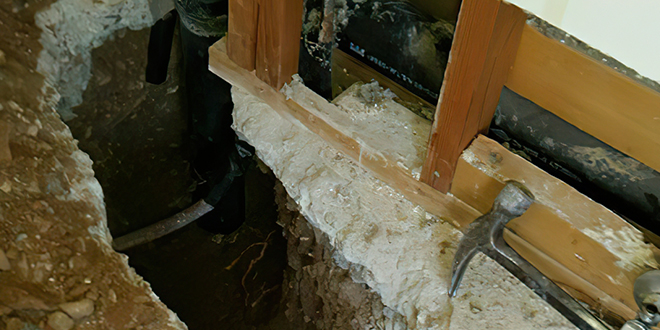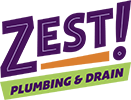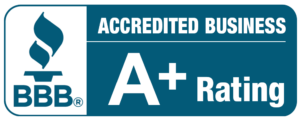The plumbing is an essential component in your home, providing you with hot showers, clean laundry, and a fresh flush of the toilet after every use. While many parts of your plumbing system are easily accessible, others are buried beneath your home.

It’s important to understand some of the hidden plumbing issues that you may encounter so you can address complex problems such as slab leaks quickly and efficiently, should they occur.
What Is a Slab Leak?
A slab leak is a water leak that occurs beneath the concrete foundation that supports your home. A slab leak may be the result of poor installation, shifting soil, or damage to the water lines. Since these water and sewer lines are buried beneath the building, you may not know that anything is wrong until the leak has already become serious.
Signs You Have a Slab Leak
It’s important to identify and repair a slab leak as quickly as possible. Left untended, the leak may cause soggy ground beneath your home that threatens its structural integrity. The foundation may crack and separate, leaving you with a slew of expensive repairs to restore your home to its former glory. Watch for these warning signs so you can diagnose and address a slab leak early.
Hot Spots on the Floor
Have you noticed that some parts of the floor are inexplicably warm or hot to the touch? This happens when hot water lines leak beneath your foundation. In this case, a plumber can use thermal imaging to locate and assess the leak. Hot spots are more noticeable on bare floors than carpet.
Water Damage
Any signs of water damage can also be signs of a slab leak. An early indicator may be a damp or musty smell. Moisture has a distinct aroma. In the home, it’s often combined with the unpleasant smell of mold or mildew. These microbial growths love dark, damp environments and will quickly take up residence anywhere you have standing water beneath the house or in the flooring.
If the leak has progressed into your home, you may see dark spots on the carpet that feel damp to the touch. Linoleum, laminate, and hardwood floors might begin to warp from water exposure. Visible puddles or pools of water are an obvious sign of trouble. Whether these problems are caused by a slab leak or some other type of leak, call our professionals at Zest Plumbing and Drain right away for a plumbing inspection and plan of action.
An Increased Water Bill
If you’re going about your standard routines but your water bill is on the rise, you’re losing water somewhere that you shouldn’t. Before you jump to conclusions, make sure you haven’t made any recent habit changes, such as turning on the sprinkler system for summer or having visitors stay at your home for a week. If all has been business as usual, you should contact a plumber to investigate further.
Reduced Water Pressure
When you have an active leak in your home, water may seep out of the pipes before it reaches your water fixtures. This will result in a decrease in water pressure. If your faucet and shower don’t provide the pressure you’re used to, it’s important to find out why. A hidden slab leak could be the culprit.
The Sound of Running Water
When you listen closely, do you hear running water? Turn off all the faucets, appliances, and other fixtures in your home and pay attention to any remaining sounds. If you can hear running water when there is none, this is a sign of a leak somewhere. It could be lurking beneath your slab, where only professional detection devices are likely to find it.
Repair Options
There are several ways to repair a slab leak. Not all options are appropriate for every situation, so it’s important to have a skilled plumber assess your situation and offer an expert recommendation. Some of the options include pipe lining, re-piping, pipe bursting, and re-routing.
Pipe Lining
Pipe lining goes by many names, including in-line pipe repair and trenchless pipe rehabilitation. Pipe lining is the process of lining the existing pipe with a new substance to stop the leak. You need only two access points to complete this job. Plumbers may use a variety of tools and products for pipe lining, including inflatable lining that pulls through the pipe and cures in place and cured-in-place coatings that are pushed through the pipe.
Re-Piping
Re-piping is an invasive repair option that’s typically used only when there are multiple leaks in the pipe and pipe lining isn’t sufficient. To re-pipe the home, your plumber will need to cut through the floor and concrete slab to install new pipes.
Pipe Bursting
Pipe bursting is the process of destroying the existing pipe and simultaneously replacing it with a new one. A special tool runs inside the old pipe and bursts it as it moves forward, dragging the new pipe behind it. This option is best for situations where it’s not possible to save the existing pipe or sewer line with pipe lining.
Re-Routing
Since significant pipe repairs under the slab foundation can be quite invasive, some plumbers will opt to simply re-route the pipe instead. The plumber will first identify the problematic pipe, then run a new pipe through an entirely different route, such as the attic. This re-routed pipe bypasses the damaged pipe entirely.
Contact Zest Plumbing and Drain for Slab Leak Repair
Repairing a slab leak isn’t something you should approach as a DIY job. This is a major task that requires the skilled hand of a professional. If you suspect a leak of any kind, contact our team at Zest Plumbing and Drain in Scottsdale, Arizona, immediately. We have the tools and training that you need to find and fix a slab leak. Licensed and insured, our plumbers are well-equipped to take care of all your plumbing needs.




